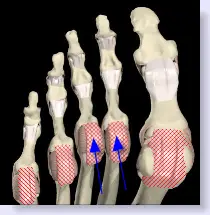 If you are planning on going to the beach this summer and walking around barefoot, follow these tips from the American College of Foot and Ankle Surgeons.
If you are planning on going to the beach this summer and walking around barefoot, follow these tips from the American College of Foot and Ankle Surgeons.1. Puncture Wounds and Cuts.
Wear protective shoes so your foot does not get cut by broken glass, sea shells, and other sharp objects that may be on the beach. If you do get a cut, do not go into the water, as bacteria already present in lakes and oceans can cause infections. A serious puncture wound on the foot should be treated by a podiatrist within twenty-four hours of occurrence.
2. Jellyfish Stings
Even if the jellyfish has washed ashore it can still sting you if you get too close. If tenacles stick to your foot or ankle, remove them, taking caution not to sting your hands as well. Jellyfish stings can be treated with vinegar, meat tenderizer, or baking soda to reduce swelling and pain.
3. Sunscreen
Skin cancer can appear on the foot and ankle like any part of your body. Take precautions and apply sunscreen to your feet and ankles on the top and bottom.
4. Burns
Hot pavement, concrete, or asphalt can cause severe burns on the bottom of your foot. Remember to wear protective shoes when you are walking on all kinds of surfaces.
5. Ankle Injuries, Arch and Heel Pain
While playing a game of beach volleyball or running on the sand, you can accidentally twist your ankle. Performing athletics on uneven surfaces can cause arch and heel pain , especially if you are wearing flimsy flip-flops or sandals. If you injury yourself, remember to RICE: Rest, Ice, Compress, and Elevate.
6. Diabetic Risks
People with diabetes shoul be especially careful since they often do not feel when they get a cut or if something is lodged in their foot. If you have diabetes, never go to the beach without protective shoes and if you take them off, have someone check for foreign objects.
Dr. Tina A. Boucher, DPM
Central Connecticut Foot Care, LLC Meriden, CT Podiatrist
http://www.centralctfootcare.com/
Order your free copy of our books "Why Do My Feet Hurt?" and "Heal My Heel!" today!


